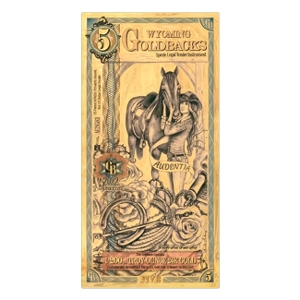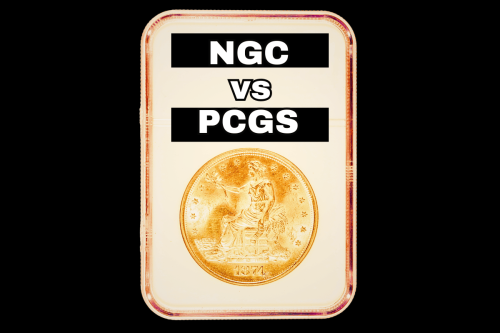
Is There a 1,000 Dollar Bill?
In a 1998 episode of The Simpsons, rich tycoon Monty Burns is discovered to have in his possession a trillion-dollar bill, printed in 1945 by then-President Harry Truman. Burns, in typical form, failed to deliver the bill to war-torn Europe as promised, instead keeping it for himself.
The idea of a one trillion dollar bill is certainly humorous, and while there hasn't ever been a bill that large, the United States does have a curious history of some large bills, including a 1000 dollar bill.
These high-denomination bills, often referred to as "big bills," were once a part of the U.S. currency system, although they are now out of circulation. The $1,000 bill, in particular, holds a mystique due to its rarity and the questions it raises about its purpose and existence.
In this blog post, we'll look at the intriguing history of the $1,000 bill, exploring its origins, significance, and whether any still exist today. Let's uncover the story behind one of America's fascinating pieces of currency.
Introducing the $1,000 Bill
The $1,000 bill stands as a symbol of American monetary history. Introduced in 1861 during the Civil War, it played a crucial role in facilitating large-scale financial transactions and funding military endeavors.
Alexander Hamilton's portrait graced the $1,000 bill in the 1918 series of banknotes. However, in 1928, amid concerns about counterfeiting and to facilitate easier recognition, Hamilton was replaced by Grover Cleveland, a former president known for his economic policies. The $1,000 bill represented the economic resilience and stability of the nation during a tumultuous period in its history.
Its circulation was limited to interbank transfers and transactions among large financial institutions, highlighting its importance within the banking system. Despite its utilitarian purpose, the $1,000 bill also captured the imagination of the public, embodying the aspirations and achievements of the United States during an era of rapid industrialization and expansion.
Other High-Denomination Bills
The $1,000 bill wasn't the only high-denomination bill in US history. In fact, alongside the $1,000 bill, several other high-denomination bills were circulated, each with its own unique story and significance in American monetary history.
The $500 Bill
Introduced alongside the $1,000 bill in 1861, the $500 bill featured President William McKinley's portrait. Despite its lesser denomination, it served a critical role in facilitating substantial financial transactions. Its circulation aided banks and businesses during periods of economic growth, providing a means for efficient interbank transfers.
The 500 dollar bill symbolized stability and prosperity, reflecting the nation's confidence in its expanding economy. Though less common than its higher-denomination counterparts, it remained an essential component of the U.S. currency system, contributing to the smooth operation of financial transactions on a grand scale.
The $5,000 Bill
Introduced in 1918, the $5,000 bill featured President James Madison's portrait. This high-denomination bill played a crucial role in facilitating interbank transfers and large financial transactions.
Despite its rarity, it symbolized the strength and stability of the U.S. economy during times of economic turbulence. The $5,000 bill served as a testament to America's growing financial power and its ability to navigate challenges in the banking system.
The $10,000 Bill
The $10,000 bill, introduced in 1934, displayed Salmon P. Chase, Secretary of the Treasury during the Civil War. As the highest denomination ever circulated to the public, it held significant value in facilitating large financial transactions and interbank transfers.
Although rare, the $10,000 bill represented a pinnacle of American monetary history, showcasing the nation's economic prowess and its ability to innovate in the realm of currency.
Fans of The Simpsons may also remember a humourous scene in the Mr. Plow episode, where Homer tempts Barney to undertake a dangerous snow plow job with the incentive of a $10,000 bill. When Barney asks which president is on the bill, Homer responds by saying "Uh, all of them. They're having a party. Jimmy Carter's passed out on the couch."
Why Was the $1,000 Bill Created?
Now, let's return for a closer look at the incredible $1,000 bill, which emerged from a necessity for efficient large-scale transactions in the early 20th century. This was driven by the expanding complexity of the American economy and the increasing need for streamlined financial operations.
Facilitating High-Value Transactions
As the United States entered the 20th century, its economy underwent rapid industrialization and expansion. With the rise of large corporations and the growth of international trade, there arose a demand for a currency denomination that could accommodate high-value transactions swiftly and securely.
The $1,000 bill filled this niche, providing a convenient means for banks and businesses to conduct substantial financial exchanges without the hassle of managing bulky amounts of lower-denomination currency.
The Role of the Federal Reserve System
The creation and circulation of high-denomination currency, including the $1,000 bill, were closely regulated by the Federal Reserve System. Established in 1913, the Federal Reserve acted as the central bank of the United States, overseeing the nation's monetary policy and regulating the supply of currency in circulation.
Through its network of regional Reserve Banks, the Federal Reserve managed the distribution of high-denomination bills, ensuring their availability where needed while safeguarding against counterfeiting and misuse.
Regulating and Distributing High-Denomination Currency
The Federal Reserve System played a pivotal role in regulating and distributing high-denomination currency, including the $1,000 bill. By controlling the issuance and circulation of these bills, the Federal Reserve maintained stability and confidence in the nation's monetary system.
Through its oversight and coordination with financial institutions, the Federal Reserve ensured that high-denomination currency served its intended purpose of facilitating large-scale transactions while minimizing the risks associated with their use.
The Decline of High-Denomination Currency
Over time, high-denomination currency, like the $500, $1,000, $5,000, and $10,000 bills, started fading away for a few reasons. Here's why you don't see these in circulation anymore.
Factors Leading to Decline
The decline of high-denomination currency was driven by advancements in banking technology and concerns about illicit activities. With the rise of electronic transfers and digital payment systems, the need for physical cash, especially in large denominations, decreased significantly.
These modern banking solutions offered faster, more secure alternatives for conducting transactions, making high-denomination bills less essential in everyday commerce. Additionally, heightened awareness of money laundering and other illegal financial activities prompted increased scrutiny of large cash transactions. This lead to tighter regulations and oversight.
In response to these trends, the U.S. government made the decision in 1969 to discontinue the printing and circulation of high-denomination bills, including the $500, $1,000, $5,000, and $10,000 denominations.
Limited Legal Status Today
Today, high-denomination bills like the $500, $1,000, $5,000, and $10,000 denominations still hold legal status as a valid currency. However, their presence in everyday transactions is exceedingly rare. Most people opt for smaller bills or electronic payment methods for their day-to-day purchases.
While these large bills are technically accepted for payment, they have largely become relics of the past, sought after more for their historical value than their practical use. Money collectors and enthusiasts may treasure them, but they have little impact on the average person's financial dealings.
As electronic banking and digital currencies continue to dominate the financial landscape, the likelihood of encountering high-denomination bills in circulation grows increasingly slim.
The Purchasing Power of the $1,000 Bill Over Time
When the $1,000 bill was first introduced, its purchasing power would have been significant. However, determining its exact value in today's money requires considering inflation and changes in the cost of living over time.
In 1918, when the $1,000 bill featuring Grover Cleveland was introduced, $1,000 represented a substantial sum of money. According to historical records, the average annual income in the United States around that time was roughly $1,300 to $1,500. Therefore, a $1,000 bill would have been equivalent to several months' worth of wages for the average American worker.
To estimate its value in today's money, we can use an inflation calculator. Based on calculations using the Consumer Price Index (CPI) inflation calculator provided by the Bureau of Labor Statistics, $1,000 in 1918 would be equivalent to approximately $17,000 to $19,000 in 2024.
So, if we were to adjust for inflation, the purchasing power of a $1,000 bill from 1918 would be roughly equivalent to having between $17,000 to $19,000 in today's money. This illustrates just how valuable and significant these high-denomination bills were in their time!
Legacy of High-Denomination Currency
The legacy of high-denomination currency in the United States is a testament to the nation's economic evolution and the changing dynamics of its monetary system. While no longer in circulation, high-denomination bills like the $1,000 bill continue to hold a special place in American history and culture.
These large-denomination bills symbolize a bygone era of economic prosperity and financial innovation. They served as tangible representations of the country's economic strength and stability. They reflect a time when the United States emerged as a global economic powerhouse.
Despite their rarity and limited use, high-denomination bills remain highly sought after by collectors and enthusiasts of numismatics, the study and collection of currency.
Their intricate designs, historical significance, and scarcity make them prized possessions among collectors who appreciate their cultural and monetary value.
Moreover, the legacy of high-denomination US currency extends beyond the world of numismatics. These bills serve as reminders of the economic challenges and triumphs that shaped the nation's history. They evoke a sense of nostalgia for a time when cash transactions were more commonplace and when the face value of a bill could represent a significant portion of one's wealth.
High-Denomination Currency Around the World
While high-denomination currency is commonly associated with the United States, many other countries have issued their own versions of large-denomination bills throughout history. Here are some other global examples to be aware of.
European Examples
During the late 19th and early 20th centuries, countries like Germany, France, and Italy issued high-denomination currency to facilitate large transactions. For example, Germany issued the 1,000 Mark in the early 20th century, France had the 1,000 Franc during the same period, and Italy introduced the 1,000 Lira in the late 19th century.
These bills were commonly used by banks and businesses for significant financial exchanges, reflecting the economic prosperity of the time. While no longer in circulation, they remain significant artifacts of European monetary history, showcasing the economic strength and stability of their issuing nations during that era.
African Examples
In Africa, Zimbabwe experienced a notable instance of high-denomination currency issuance during the late 20th and early 21st centuries.
Amid severe hyperinflation in the 2000s, Zimbabwe introduced the infamous 100 Trillion Dollar bill, which holds the record for the highest denomination ever printed. This astronomical denomination reflected the staggering levels of inflation that plagued the country, rendering its currency nearly worthless and causing immense economic turmoil for its citizens.
The 100 Trillion Dollar bill serves as a stark symbol of Zimbabwe's economic crisis. It represented the extreme consequences of hyperinflation and mismanagement of monetary policy.
While no longer in circulation due to the adoption of foreign currencies like the US dollar and the South African rand, it remains a poignant reminder of the country's turbulent economic history and the challenges it faced in maintaining stability and prosperity.
Asian Examples
Asian countries like Japan and China indeed had high-denomination currency. In Japan, the 10,000 Yen bill was a notable high-denomination currency, featuring historical figures like Yukichi Fukuzawa and Hideo Noguchi. This bill facilitated large transactions and reflected Japan's economic prowess.
Similarly, China issued the 10,000 Yuan bill, showcasing iconic landmarks like the Great Wall of China. This high-denomination currency played a significant role in facilitating substantial financial exchanges and represented China's economic strength on the global stage.
Both the Japanese 10,000 Yen bill and the Chinese 10,000 Yuan bill remain important symbols of economic prosperity and stability in their respective countries.
Highest Denomination Currency in Circulation Today
In the United States today, the highest denomination currency in circulation is the $100 bill. With Benjamin Franklin's portrait adorning it, this bill is widely recognized and accepted for large transactions across the country.
Whether it's buying groceries or saving up for something special, the $100 bill plays a crucial role in everyday financial transactions. It offers a convenient and reliable way to handle significant sums of money.


Is There a 1000 Dollar Bill?
So, let's sum up by saying yes, there is a 1000 dollar bill. While not commonly seen in circulation, the $1,000 bill was once issued by the United States government. Featuring a portrait of President Grover Cleveland, these bills were primarily used for large transactions between banks and are now prized collectibles.
Interested in investing in precious metals? Discover the world of gold, silver, and platinum coins from the U.S. Mint with the United States Gold Bureau. Click here to receive your free precious metals investor guide and start your journey toward secure investments today.









